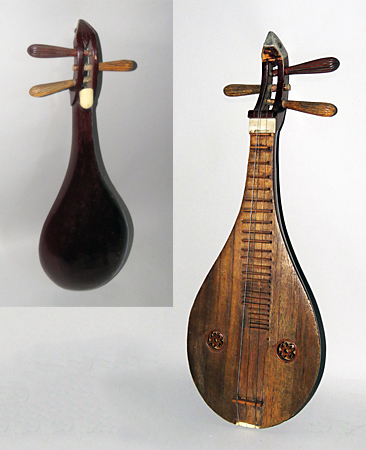
Owner: HWMC
Catalogue #: 2AS-CHLT-70
Lutes
China 'Liuqin' (C) 3-String
China – Wan Huiran Musical Instrument Factory
Chinese
Mahogany, wood, bone, metal strings
ca. 1958
Length: 24.25 in, Width: 9 in, Depth: 2.75 in
Chordophones – Lutes
The liuqin is a small string, pear-shaped plucked lute of the Han Chinese and has been very popular in the folk region of Shandong, Anhul, and the Jiangsu provinces in East China. It is named liuqin or liu ye qin as it is made from the wood of the willow tree. It is also known as the tu pipa (‘native’ pipa’), meaning rustic and simple, and looks like a smaller version of the pipa. The instrument is held in a slightly tilted upright position in the lap with the left hand supporting the neck. It is played in the same manner as the pipa, with a triangular acrylic plectrum held by the right hand between the thumb and index finger. The liuqin has a shallow sound box and sounds similar to a mandolin.
During the Qing Dynasty it experienced much popularity, but had only two strings, and was used for accompaniment purposes in traditional operas. Then in late 1958, a group of workers from the Wan Huiran Musical Instrument factory invented a three-stringed liuqin with 24 frets. Compared with the pipa, this new instrument had an enlarged range and produced brighter tones. In the 1970s, the same factory created another new type of liuqin, adding another string and more frets. Most importantly, the shaft of the Chinese sorghum replaced the bamboo, and the strings were made of steel instead of silk. Today the 4-string liuqin is used throughout China as a solo instrument rather than only as accompaniment in the Chinese orchestra, and is experiencing a new popularity.
Resource: “Liuqin”; Alan R. Thrasher/Goria N. Wong, “The Grove Dictionary of Musical Instruments,” second edition; Laurence Libin, Editor in Chief. //https://en.chinaculture.org/created/2005-12/05/content_76661.htm
